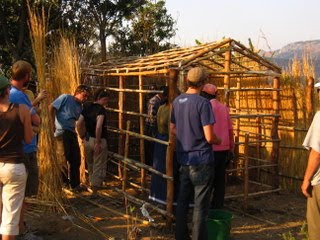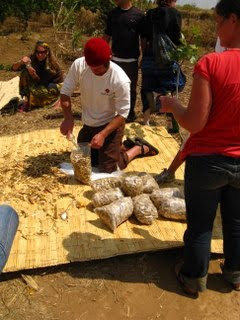We arrived at Mau Mission after a 1 1/2 hour drive and a thousand meter drop in elevation.
Inside the cultural center there is native christian art...
A history of the mission and early missionaries. That's Dr David Livingston on the top right. He was one of the first white men in this part of Africa.
More history...
The first black priest who became the first black bishop here.
Crafts for sale.
A large outdoor sculpture.
The outside of the museum has a history of this part of Africa in murals - this is just part of it. Inside is a lot of African tribal cultural information and artifacts. Unfortunately photos were not allowed.
Monday, August 24, 2009
Mua Mission
Posted by Jim Hemminger at 9:49 AM 0 comments
Mushroom House
This 2 day training was about how to set up a mushroom growing business. First step is to build a house to grow them in. People here know how to do this - the materials are gathered locally: wood poles, grass for a fence to protect the house from goats and even inner bark of young trees for rope, although in this case we used nails.
Meanwhile others chopped corn stalks into small pieces which were washed to remove dirt and mold spores and spread on mats to dry.
Sanitation is important to prevent contamination which would spoil batch and waste time and money. We wash hands with soap and water then disinfect with mentholated spirits.
Here the substrate (chopped corn stalks) are packed into plastic bags and inoculated with Oyster mushroom spoors.
Here is the finished house. The frame is covered with plastic to keep out dirt and keep in moisture and heat. There are shelves inside where the plastic bags are placed. In about 6 weeks mushrooms will begin popping through the plastic and they can be harvested for 3 or 4 months. This project requires daily attention and good management.
At the end Mr Chaonya thanked us for our work. He is a retired extension worker who is well educated and does many interesting and unusual (for here) things like grafting, budding and raising peaches and apples.
Here is our PC crew, Mr Chaonya and a couple of guys who helped build the house. I am in the middle, back row with the hat.
Posted by Jim Hemminger at 8:47 AM 0 comments
Sunday, August 23, 2009
Making Bricks
The cold season, between harvest and planting time, is the time to make bricks. My village, Lipunga, has decided to build a health center. A man from the village who is now well off and a politician has found funding sources to build the building. The community contribution is to mold the bricks and everyone knows how to do it.
Since this is a community project a piece of customary land is used to make the bricks. The first step is to clear the area of trees and brush.
The soil here is a mixture of sand and clay which makes good bricks. The men start digging with their khasus.
Then the women bring water which they pour on the loosened soil.
This makes the mud to mold the bricks.
Wooden forms are filled with the mud.
And dumped out on the ground.
Here are a bunch of bricks from another site.
Finally the bricks are stacked into piles with tunnels underneath and covered with mud. Then trees are cut and logs burned in the tunnels for a day to fire the whole pile of bricks. The pile is taken apart and used to build.
Posted by Jim Hemminger at 4:22 AM 1 comments
Cold Season Work
Mid-May to mid-August is called the cold season in Malawi. In my area this means temperatures between 55 and 80 degrees, so it's almost like summer weather for me. During this time, after harvest and before planting, many chores are done. This woman is "smearing" her house with clay to make it look good.
A typical wheelbarrow used for many hauling chores. Notice the bearings are missing from the wheel. This is also typical.
This is a pile of groundnut or peanut vines after the women removed the groundnuts. The vines will be fed to cattle unless the goats get them first. The cold season is also very dry and goats are left loose to find what they can.
This man is making a chair from branches of a type of palm tree. They also make tables. This furniture is held together with pegs made from the same branches and is very lightweight and not too durable.
These men are building a house with rammed earth using a simple wooden form. These houses are small with thatched roofs, tiny rooms and mud floors. If people can afford it they want to build a brick house with a metal roof and concrete floors.
Posted by Jim Hemminger at 3:14 AM 0 comments
Fish Ponds
One of the IGAs (Income Generating Activities) we promote is fish farming. This group in Singa village is just starting to dig a pond to raise fish.
It's a lot of work. This pond is 10 x 20 meters and 1 to 1 1/2 meters deep. A meter is 39 inches, or a little over a yard.
Harvesting fish with a net at an established pond in Chilikonda village
We have fish!
Not a huge harvest but we caught 28 big ones and a bunch of little ones. People really like fish but can't afford to buy it often. Raising fish is not easy. As you can see digging a pond is a lot of work. After that it must be stocked with fingerlings and they must be fed twice a day and protected from predators, both animal and human.
Posted by Jim Hemminger at 2:57 AM 0 comments
Sunday, August 16, 2009
Scenes from Malawi
Here I am on the road from Mchinji, where I get supplies and internet access every few weeks, with Mr Lipunga, my landlord.
Stopping for a water break.
Every so often we meet a cow-cart carrying corn, manure, tobacco or almost anything.

A woman carrying sugar cane - and a baby. She harvests it down along the river and sells it along the road for about 15 cents a stalk. It is a popular snack and is very refreshing in hot weather.

Gule wa Nkulu dancers walking down the road to a performance. They stopped to let me take their photo. This is a cultural tradition. If you ask who these guys are people will say it's a mystery or they come from the river (kind of like we do with Santa or the Easter Bunny).

Onions being transplanted from nurseries into beds along the river. Onions are a big crop in this area.

Something is always burning and it gets worse this time of year. Crop residue is burned to clear the land for planting. The grass in the bush, as in this photo, is burned to make hunting easier. Leaves and trash are burned around houses and in the towns and villages. It's really bad but hard to change.
Posted by Jim Hemminger at 12:44 AM 1 comments
More Scenes from Malawi
Here is Mr Petro Shawa and some of his extended family behind their house.
This is harvest time and most of the crops have been brought in from the fields. These women are shelling groundnuts or peanuts.
There are many tearooms along the dirt roads. Usually there will be 4 heaping spoonfuls of sugar and either 4 heaping spoonfuls of powdered milk or fresh milk if available in the teas. You can also get "scones" which are those tall bread things made in a wood-fired brick oven by the owner.
Posted by Jim Hemminger at 12:27 AM 0 comments

















































